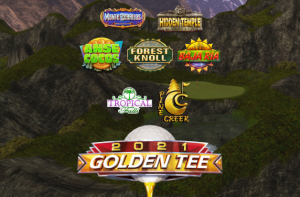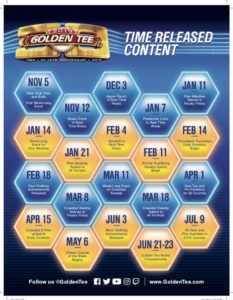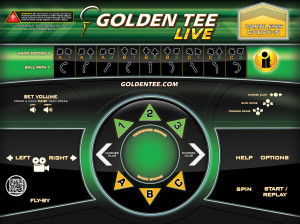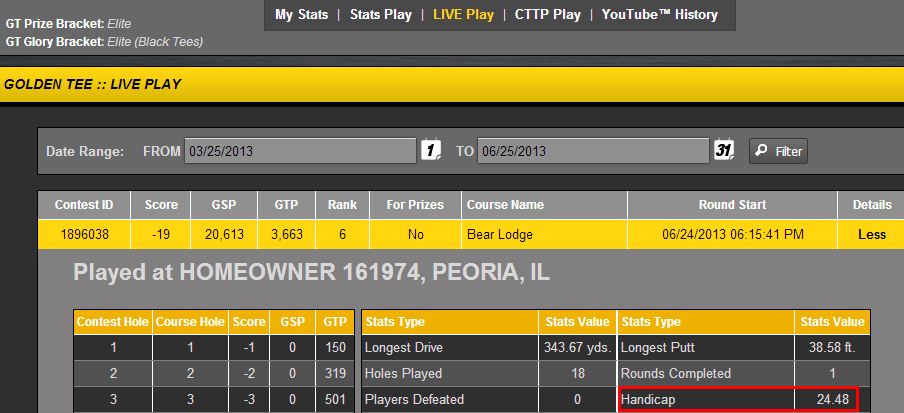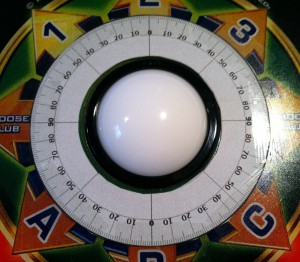Course designer Jim Zielinski proves year in and year out that he knows how to close out a round. When you step up to the 18th tee, you know that almost always an eagle is there for the taking, but almost always it’s really tough to get. And if the risk/reward doesn’t pay off, a good round can easily be erased.
Golden Tee 2015 will give us 5 more challenging finishing holes to bring the total to 50, but it’s never a bad time to take a look back and evaluate the designs over the last 9 years. But how do we properly evaluate these holes both individually and against each other? To me, there are 3 main categories in play that determine a hole’s difficulty. Let’s look at them in some detail.
1) The Obstructions:
What is blocking your path to the hole? Sometimes, it’s nothing. But many more times, your skill will be tested by landscape features obstructing an easy path to the hole. Obstructions force you to execute at least one of the following 3 shots: shooting over or under something, curving the ball around something, or shooting directly through something such as a gap in the trees.
2) The Green:
To go even further, there are 3 features of the green that also directly affect its difficulty: size, shape, and slope. A small green is difficult to stick, and you’ll almost always need to stick it to have a chance at eagle. The shape of the green can also cause havoc. A circle is the easiest, but some are very narrow, crescent-shaped, or wavy, creating situations where even if you stick the green, you may not have a putt at the hole. And of course the slope matters, because as slope rises, so do missed putts (including the dreaded rollovers).
3) The Hazards:
Hazards are your penalty for missing the green, and they are often present on multiple sides of the hole. While water is the most common (and most penalizing), deep bunkers or rough lies can also make for difficult recovery from an errant approach.
Finally, two more factors play into the difficulty of the closing hole. The first is elevation changes. Shooting uphill into a green or floating a shot downhill into a green both increase the difficulty over a flat approach. The second is what I call reachability. Given the most difficult setup on a given hole, are you still able to get the ball to the green? Sometimes the answer is no, and you’ll lose your eagle opportunity by having to bail out, lay up, or go for it anyway (unsuccessfully).
Rating the Holes:
Now that the categories have been identified, it’s time to evaluate each hole. A persistent practice is a rating scale of 1-5 for each identified category, where 5 is the toughest and 1 is the easiest. Whatever course racks up the most points will be determined the most difficult.
The Greens:
For the difficulty of the greens, the course gets a rating in each of the 3 subcategories, and those are averaged out for an overall score. For slope, a couple courses (Cape Haven, Great Wall) earned a 5 for having slopes greater than 10. A slope of 10 gets a 4, and a flat green gets a 1. For size, the greens were all compared to each other. The largest greens got a 1, and the smallest greens got a 5. For shape, a circle gets a 1. The closer it was to a circle, the closer the rating to a 1. The craziest, toughest shapes got a 5.
Results: Bella Toscana and Monument Valley tied for the toughest 18th hole greens. Laurel Park has the easiest.
The Obstructions:
Difficulty of obstructions depends on type and severity. If the hole has no obstructions, it got a 1 in the category. From there, I had to determine the percent of time particular obstructions were present off the tee, and how severe they were. A severity of 5 means that you need a full cut around the obstacle or that you need to shoot through a tiny gap. Over/under obstructions were weighted slightly less because they are less difficult to overcome. So, the overall obstructions rating takes into account all the tee boxes and how often you are placed in them.
Results: Tahiti Cove blocked the most of your path to the green, followed by Glacier Ranch and Misty Springs. Many holes had no obstructions.
The Hazards:
What’s the penalty for missing the green? I looked at all 4 sides around the green and averaged the penalty for misses on each side. I also looked at a “close” miss and a “far” miss, since inaccuracy can vary widely among players and per round, but I gave more weight to the “close” miss. The hole earned a 5 for water (or lava), 4 for the potential for water or a steep blocking bunker, 3 for a tough recovery, 2 for a difficult lie such as dust or mud, and 1 for a straight fairway or rough lie.
Results: Coral Vista‘s island green is the toughest because you can’t miss anywhere, followed right behind by Heather Pointe and Tundra Peak. Tahiti Cove and Jackrabbit Junction are the most generous holes for an errant approach.
Elevations: In the scoring, elevation changes were weighted at half, because they don’t pose a problem as tough as the others. All the holes were evaluated against each other, and Tundra Peak and Monument Valley earned top points for having to shoot way up and way down, respectively.
Reachability: A course gets a 5 in this category if you can find yourself in multiple setups where you just can’t get the ball to the green. Bear Lodge and Cypress Cove both took 5s here. The course gets a 4 if it can have an extremely difficult setup for most players and a 3 if there are distance-challenging setups for some players. The course gets a 1 if distance is never an issue.
So let’s take a break and see where we are. After plugging in data for greens, obstructions, hazards, elevation changes and reachability, we have the top 10 most difficult holes, as follows:
Misty Springs
Sequoia Grove
Coconut Beach
Cypress Cove
Bear Lodge
Summit Lakes
Monument Valley
Kangaroo Trail
Dusty Bend
Bella Toscana
Now data is good, but it’s not everything. There’s a reason the BCS Formula incorporates a human element, and I wanted to do the same thing. The Golden Tee players who have been attacking these holes for years certainly have a pretty good idea of the easiest and hardest closing holes in the game, so I reached out to them to get their votes. Here are the users’ top 10 most difficult holes:
Misty Springs
Coconut Beach
Moose Landing
Kangaroo Trail
Summit Lakes
Tundra Peak
Bella Toscana
Shady Acres
Sequoia Grove
Glacier Ranch
Given that valuable user input from the community, I combined my data with their votes to come up with my final results. I now give to you the GoldenTeeFan list of top 10 most difficult closing holes in the Golden Tee LIVE era:
1 – Misty Springs
2 – Coconut Beach
3 – Summit Lakes
4 – Sequoia Grove
5 – Bear Lodge
6 – Kangaroo Trail
7 – Bella Toscana
8 – Tundra Peak
9 – Cypress Cove
10 – Timber Bay
In addition, here are the easiest closing holes in the game:
1 – Turtle Island
2 – Highland Links
3 – Laurel Park
4 – Cape Haven
5 – Indigo Mound
Click here to see the full breakdown per course and how each ranked in the various categories in play.
As a final exercise, I wanted to compare the data rankings to the user rankings to see where there was a wide variation. The top 6 examples are below, and I’ll attempt to rationalize the difference:
Having played Cypress Cove many, many times for the Classic Course of the week this summer really put this one in perspective for me. If you are pinned to the left or right and have to curve a shot around into a tough wind, sometimes you can’t even get the ball to the green. That was a big contributing factor (reachability) to its difficulty rank. I’m under the impression that the players most often remember the straight shots from the middle two tee boxes, which are indeed very favorable. But it’s the tough tee boxes you get the other half of the time that can really make this a tough eagle.
For Moose Landing and Black Hills, I have to agree with the voters that it should have been higher. Perhaps the lack of obstructions on the way to the hole gave these courses an unfairly low score relative to the rest of the field, because they are really tough.
For Monument Valley, I’m sticking with the data. With a 15 wind in your face here, eagle is almost impossible, as if it wasn’t hard enough already. Floating a shot downhill while fighting a wind is very difficult, and there may as well be water all around the green because of the rock deflections. Factor in the shape of the green and this one is an awfully tough eagle.
Jackrabbit Junction has some setups where many players can’t even get to the green in two, and that’s the main reason why the data score this hole more difficult than the users. It’s not always easy to blast a drive out to the second fairway and bring it in for eagle.
Finally, Eagle Crest has difficult setups in the corners that make me lean with the data rank. Not only do you need an accurate curve around the trees, but it’s very difficult to nail the distance. Long is water, and short is almost always the dust. That dust eats up anything short that may otherwise hop down onto the green.
So is it perfect? Of course not. The beauty of this game is that so many factors make up the difficulty of a hole, even others that I chose not to evaluate or that you cannot evaluate (club selection, touch required, intimidation factor, a player’s particular skill on one hole vs. another, and so on). But it sure was a fun experiment, and I do believe I got it pretty close. You’re not alone when you’re shaking in your boots on the Misty #18 tee, but we can hope that 2015 and beyond doesn’t bring too many more closers as demanding.
